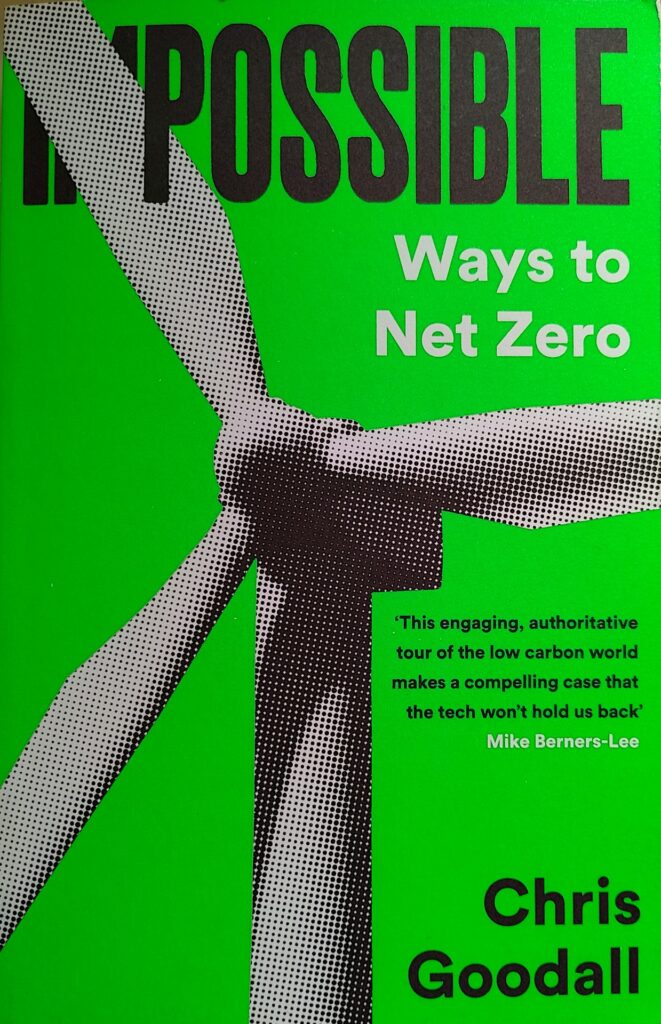First published 2024. Profile Books paperback, 2024, pp 368, c.90,000 words.
This is a very accessible analysis of how likely the world is to get to net zero (increase in CO2 in the atmosphere from human related sources) by 2050. On the whole it presents an optimistic picture, making a convincing case that plausible routes exist for eliminating or mitigating all major CO2 emissions. Mostly this view is based on reviews of the necessary technologies and analysis of the economics of each to give a feel for how likely the technologies (or superior replacements) are to be implemented.
Goodall starts his analysis by looking at electricity. This is the most solid ground because today electricity can be generated most cheaply in most parts of the world from zero-carbon sources. (This review often uses the common misnomer ‘carbon’ in place of the more awkward ‘CO2’.) And the costs of electricity generation from solar and wind continue to decline. The significant problem with the intermittency from these sources can be overcome through energy storage and links to move power around. Private capital is flooding in to the generation side, but not yet widely enough in the storage and distribution side. Governments often jealously hold on to distribution and are reluctant to raise the capital needed to pay for grid enhancements themselves by increasing taxes.
There has been a major change in thinking over the past five years or so on energy storage. Hydrogen, long favoured by the Japanese, is now in fashion. Electrolysers, using electricity to split hydrogen out of water, are moving towards economic viability on a large scale, and hydrogen storage, mostly in salt caverns, seems realistic. Hydrogen can also be transported over long distances by pipeline or ship with much smaller losses than electricity. This may allow solar energy to be collected where it is strongest and the energy moved to northern countries where there is greatest demand.
From there, pretty much all else flows. Electricity and hydrogen are shown to be possible substitutes for fossil fuels in all major industries and transport. Steel and cement used to be seen as real challenges to achieving net-zero, but, as Goodall describes, there are now clear ways forward that are being tested at industrial scale. Many of the very large companies involved are building production facilities using these approaches, he says, largely driven by demand from customers who are keen to show their own efforts in reducing carbon emissions. No longer are many of these big companies mouthing what appeared to sceptics like me as greenwashing.
It is not going to be all plain sailing to net zero by 2050. The least likely industries to achieve that are food and clothing – consumer facing industries. Plastics are also a tough challenge, notably important because of their part in food distribution, reducing waste and increasing shelf-life. As more of the world is lifted out of poverty, and surely we all want to see that, demand for food and clothing will keep rising. While there is likely to be some shift away from the consumption of beef in the rich world as vegetarianism increases in popularity, consumption is likely to increase elsewhere. Goodall’s answer to this dilemma is to examine the possibilities for capturing CO2 from industrial processes or directly from the air. Some promising approaches are being tested in industrial-scale projects, but these mostly require considerable energy inputs, however these are not time critical so could be run when power is abundant and cheap.
There is almost no political appetite anywhere for taxes on CO2 emissions, which economists argue is the most efficient way to bring net-zero about. There is also the problem of ensuring that poorer countries have access to capital for ‘green’ technology investments at affordable rates. The rich world will have to shoulder some of this cost too.
Goodall adds some thoughts about the benefits that the world will gain from these changes. Most notably pollution in cities will reduce and air quality rise. I am not so optimistic about the world’s appetite for a bicycle-and-public-transport along with vegetarianism as the default way of life. That may be attractive to some, but is unnecessary to achieve net-zero. No doubt at least a few countries will freeload and not pay for extraction of carbon from the air. Perhaps the world will find a solution to that problem eventually, hopefully not by war.
Goodall writes very clearly, with minimal jargon, making this accessible to the general reader. Yes, there are quite a lot of numbers, but these are necessary to give a feel for the scale of the problems and how well each sector is performing. The text is lightened with frequent illustrations using real world examples, and these are often accompanied with photographs and the occasional diagram.
While Goodall is a committed environmentalist, standing in the recent UK general election as a Green Party candidate, he is also a serious economist. Almost all the facts he presents here (326 of them) are sourced on his website, www.carboncommentary.com which is something to be greatly valued when such arguments are being made. They also allow the reader to check on progress against the net-zero target. Perhaps unusually, Goodall comes across as an optimistic environmentalist, but no Panglossian. This book is a hugely impressive summary of this enormous and complex subject.
Wikipedia biography of Goodall: https://en.wikipedia.org/wiki/Chris_Goodall
Publisher’s summary of the book: https://profilebooks.com/work/possible/
Others’ reviews of the book: https://www.goodreads.com/book/show/179941599-possible?ref=nav_sb_ss_1_25
© William John Graham, July 2024

